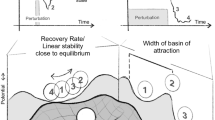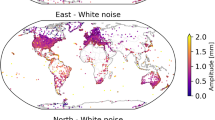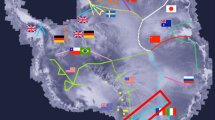Abstract
A new realization of the International Terrestrial System was computed at the ITRS Combination Centre at DGFI as a contribution to ITRF2008. The solution is labelled DTRF2008. In the same way as in the DGFI computation for ITRF2005 it is based on either normal equation systems or estimated parameters derived from VLBI, SLR, GPS and DORIS observations by weekly or session-wise processing. The parameter space of the ITRS realization comprises station positions and velocities and daily resolved Earth Orientation Parameters (EOP), whereby for the first time also nutation parameters are included. The advantage of starting from time series of input data is that the temporal behaviour of geophysical parameters can be investigated to decide whether the parameters can contribute to the datum realization of the ITRF. In the same way, a standardized analysis of station position time series can be performed to detect and remove discontinuities. The advantage of including EOP in the ITRS realization is twofold: (1) the combination of the coordinates of the terrestrial pole—estimated from all contributing techniques—links the technique networks in two components of the orientation, leading to an improvement of consistency of the Terrestrial Reference Frame (TRF) and (2) in their capacity as parameters common to all techniques, the terrestrial pole coordinates enhance the selection of local ties as they provide a measure for the consistency of the combined frame. The computation strategy of DGFI is based on the combination of normal equation systems while at the ITRS Combination Centre at IGN solutions are combined. The two independent ITRS realizations provide the possibility to assess the accuracy of ITRF by comparison of the two frames. The accuracy evaluation was done separately for the datum parameters (origin, orientation and scale) and the network geometry. The accuracy of the datum parameters, assessed from the comparison of DTRF2008 and ITRF2008, is between 2–5 mm and 0.1–0.8 mm/year depending on the technique. The network geometry (station positions and velocities) agrees within 3.2 mm and 1.0 mm/year. A comparison of DTRF2008 and ITRF2005 provides similar results for the datum parameters, but there are larger differences for the network geometry. The internal accuracy of DTRF2008—that means the level of conservation of datum information and network geometry within the combination—was derived from comparisons with the technique-only multi-year solutions. From this an internal accuracy of 0.32 mm for the VLBI up to 3.3 mm for the DORIS part of the network is found. The internal accuracy of velocities ranges from 0.05 mm/year for VLBI to 0.83 mm/year for DORIS. The internal consistency of DTRF2008 for orientation can be derived from the analysis of the terrestrial pole coordinates. It is estimated at 1.5–2.5 mm for the GPS, VLBI and SLR parts of the network. The consistency of these three and the DORIS network part is within 6.5 mm.
Similar content being viewed by others
References
Altamimi Z, Sillard P, Boucher C (2002) ITRF2000: A new release of the International Terrestrial Reference Frame for earth since applications. J Geophys Res 107(B10). doi:10.1029/2001JB000561
Altamimi Z, Collilieux X, Legrand J, Garayt B, Boucher C (2007) ITRF2005: A new release of the International Terrestrial Reference Frame based on time series of station positions and Earth orientation parameters. J Geophys Res 112(B09401). doi:10.1029/2007JB004949.
Altamimi Z, Collilieux X, Mtivier L (2011) ITRF2008: an improved solution of the International Terrestrial Reference Frame. J Geod. doi:10.1007/s00190-011-0444-4
Angermann D, Drewes H, Krügel M, Meisel B, Gerstl M, Kelm R, Müller H, Seemüller W, Tesmer V (2004) ITRS Combination Center at DGFI—a Terrestrial Reference Frame Realization 2003. Deutsche Geodätische Kommission, Reihe B, München
Angermann D, Drewes H, Krügel M, Meisel B (2007) Advances in terrestrial reference frame computation. In: Tregoning P, Rizos C (eds) Dynamic Planet, vol 130. IAG Symposia, pp 595–602. doi:10.1007/978-3-540-49350-1_86
Angermann D, Drewes H, Gerstl M, Krügel M, Meisel B (2009) DFGI combination methodology for ITRF2005 computation. In: Drewes H (ed) Geodetic Reference Frames, vol 134. IAG Symposia, pp 11–16
Bizouard C, Gambis D (2009) The combined solution C04 for earth orientation parameters consistent with International Terrestrial Reference Frame 2005. In: Drewes H, Bosch W (eds) Geodetic Reference Frames. IAG Symposia, vol 134. Springer, Berlin, pp 265–270. doi:10.1007/978-3-642-00860-3_41
Böckmann S, Artz T, Nothnagel A (2010) VLBI terrestrial reference frame contributions to ITRF2008. J Geod 84(3): 201–219. doi:10.1007/s00190-009-0357-7
DeMets C, Gordon RG, Argus DF, Stein S (1994) Effect of recent revisions to the geomagnetic reversal time scale on estimate of current plate motions. Geophys Res Lett 21(20). doi:10.1029/94GL02118
Drewes H (2009a) Reference systems, reference frames, and the geodetic datum—basic considerations. In: Sideris M (ed) Observing our changing Earth. IAG Symposia, vol 133. pp 3–9. doi:10.1007/978-3-540-85426-5_1
Drewes H (2009b) The actual plate kinematic and crustal deformation model APKIM2005 as basis for a non-rotating ITRF. In: Drewes H (ed) Reference Frames. IAG Symposia, vol 134. pp 95–99. doi:10.1007/978-3-642-00860-3_15
Ferland R (2006) Proposed IGS05 realization. IGS Mail 5447
Ferland R, Piraszewski M (2008) The IGS-combined station coordinates, earth rotation parameters and apparent geocenter. J Geod 83: 385–392
Ge M, Gendt G, Dick G, Zhang F, Reigber C (2005) Impact of GPS antenna offsets on scale changes in global network solutions. Geophys Res Lett 32. doi:10.1029/2004GL022224
Gerstl M, Kelm R, Müller H, Ehrnsperger W (2000) DOGS-CS Kombination und Lösung groß er Gleichungssysteme. Interner Bericht, DGFI, München
Gobinddass M, Willis P, de Viron O, Sibthorpe A, Zelensky N, Ries J, Ferland R, Bar-Sever Y, Diament M, Lemoine F (2009) Improving DORIS geocentre time series using an empirical rescaling of solar radiation pressure models. Adv Space Res 44: 1279–1287. doi:10.1016/j.asr.2009.08.004
Gobinddass M, Willis P, Menvielle M, Diament M (2010) Refining DORIS atmospheric drag estimation in preparation of ITRF2008. Adv Space Res 46(12): 1566–1577. doi:10.1016/j.asr.2010.04.004
Johnston G, Dawson J (2004) The 2003 Mount Pleasant (Hobart) radio telescope local tie survey. Geoscience Australia, Record 2004/21
Koch K (1999) Parameter estimation and hypothesis testing in linear models. Springer, Berlin
Mendes VB, Pavlis EC (2004) High-accuracy zenith delay prediction at optical wavelengths. Geophys Res Lett 31(L14602). doi:10.1029/2004GL020308
Michel V, Roesch G, Long J (2005) Hartebeesthoek Co-location Survey. In: Richter B, Dick W, Schwegmann W (eds) Proceedings of IERS workshop on site co-location. Verlag des Bundesamtes für Geodäsie und Kartographie, Frankfurt am Main, pp 100–109
Nothnagel A (2009) Short note: Conventions on thermal expansion modelling of radio telescopes for geodetic and astrometric VLBI. J Geod 83(9): 787–792. doi:10.1007/s00190-008-0284-z
Petit G, Luzum B (2010) IERS Conventions (2010) IERS Tech Note 36, Verlag des Bundesamtes für Geodäsie und Kartographie, Frankfurt am Main
Petrov L, Gordon D, Gipson J, MacMillan D, Ma C, Formalont E, Walker C, Carabajal C (2009) Precise geodesy with the very long baseline array. J Geod 83(9): 859–876. doi:10.1007/s00190-009-0304-7
Rodriguez-Solano CJ, Hugentobler U, Steigenberger P, Lutz S (2011) Impact of Earth radiation pressure on GPS position estimates. J Geod. doi:10.1007/s00190-011-0517-4
Rothacher M, Beutler G, Herring TA, Weber R (1999) Estimation of nutation using the global positioning system. J Geophys Res 104(B3): 4835–4859. doi:10.1029/1998JB900078
Rothacher M, Angermann D, Artz T, Bosch W, Drewes H, Böckmann S, Gerstl M, Kelm R, König D, König R, Meisel B, Müller H, Nothnagel A, Panafidina N, Richter B, Rudenko S, Schwegmann W, Seitz M, Steigenberger P, Tesmer V, Thaller D (2010) GGOS-D: homogeneously reprocessing and rigorous combination of space geodetic techniques. J Geod 85(10): 679–705. doi:10.1007/s00190-011-0475-x
Sarti P, Sillard P, Vittuari L (2004) Surveying co-located space-geodetic instruments for ITRF computation. J Geod 78: 210–222. doi:10.1007/s00190-004-0387-0
Schmid R, Rothacher M, Thaller D, Steigenberger P (2005) Absolute phase center corrections of satellite and receiver antennas, impact on global gps solutions and estimation of azimuthal phase center variations of the satellite antenna. GPS Solutions 9(4): 283–293. doi:10.1007/s10291-005-0134-x
Schmid R, Steigenberger P, Gendt G, Ge M, Rothacher M (2007) Generation of a consistent absolute phase center correction model for GPS receiver and satellite antennas. J Geod 81(12): 781–798. doi:10.1007/s00190-007-0148-y
Schön S, Brunner F (2008) A proposal for modelling physical correlations of GPS phase observations. J Geod 82(10): 601–612. doi:10.1007/s00190-008-0211-3
Schön S, Kutterer H (2006) A comparative analysis of uncertainty modelling in GPS data analysis. In: Tregoning P, Rizos R (eds) Dynamic planet: Monitoring and Understanding a Dynamic Planet with Geodetic and Oceanographic Tools. IAG Symposia, vol 130. Springer, Berlin, pp 137–142. doi:10.1007/978-3-540-49350-1_22
Seitz M (2009) Kombination geodätischer Raumbeobachtungsverfahren zur Realisierung eines terrestrischen Referenzsystems. Reihe C 630, Deutsche Geodätische Kommission, München
Springer T (2000) Modelling and validating orbits and clocks using the global positioning system. Geod Geophys Arb in der Schweiz 60. Zürich, Switzerland
Valette J, Lemoine F, Ferrage P, Yaya P, Altamimi Z, Willis P, Soudarin L (2010) IDS contribution to ITRF2008. Adv Space Res 46(12): 1614–1632. doi:10.1016/j.asr.2010.05.029
VanDam TM, Plag HP, Francis O, Gegout P (2002) GGFC Special Bureau for Loading: Current Status and Plans. In: Richter B, Schwegmann W, Dick W (eds) Proceedings of the IERS workshop on combination research and global geophysical fluids. IERS Technical Note 30, Verlag des Bundesamtes für Kartographie und Geodäsie, Frankfurt am Main, pp 180–198
Zelensky NP, Lemoine FG, Ziebart M, Sibthorpe A, Willis P, Beckley BD, Klosko SM, Chinn DS, Rowlands DD, Luthcke SB, Pavlis DE, Luceri V (2010) DORIS/SLR POD modeling improvements for Jason-1 and Jason-2. Adv Space Res 46(12): 1541–1558. doi:10.1016/j.asr.2010.05.008
Author information
Authors and Affiliations
Corresponding author
Rights and permissions
About this article
Cite this article
Seitz, M., Angermann, D., Bloßfeld, M. et al. The 2008 DGFI realization of the ITRS: DTRF2008. J Geod 86, 1097–1123 (2012). https://doi.org/10.1007/s00190-012-0567-2
Received:
Accepted:
Published:
Issue Date:
DOI: https://doi.org/10.1007/s00190-012-0567-2




